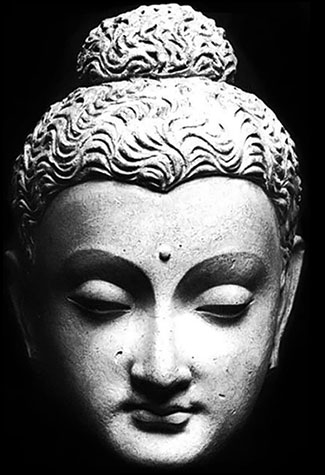The
one who became the Buddha
(a generic term meaning “Awakened One”) was reportedly born
near what is today the border between India and Nepal. He was named
Siddhartha Gautama, meaning “wish-fulfiller” or “he
who has reached his goal.” It is said that he lived for more than
eighty years during fifth century BCE, though his life may have
extended either into the late sixth or early fourth century. His
father was apparently a wealthy landowner serving as one of the
chiefs of a Kshatriya clan,
the Shakyas who lived in the foothills of the Himalayas. The family
name, Gautama, honored an ancient Hindu sage whom the family claimed as
ancestor or spiritual guide.
His mother, Maya, is said to have given birth to him in the garden of Lumbini near Kapilavastu [in contemporary Nepal]. The
epics embellish his birth story as a conception without human
intercourse, in which a white elephant carrying a lotus flower entered
his
mother’s womb during a dream.
He is portrayed as the
reincarnation of a
great being who had been born many times before and took birth on earth
once again out of compassion for all suffering beings. According to legend, the child was raised in the lap
of
luxury, with fine clothes, white umbrellas for shade, perfumes,
cosmetics, a mansion for each season, the company of female musicians,
and a harem of dancing girls. He was also trained in martial arts and
married to at least one wife, Yashodhara, who bore a son.
Despite this life
of ease, Siddhartha was reportedly unconvinced of its value. As
the legend goes, the gods arranged for him to see “four sights” that
his
father had tried to hide from him: a bent old man, a sick person, a
dead person, and a mendicant seeking lasting happiness rather than
temporal pleasure.
Seeing the first three sights, he was dismayed by the impermanence of
life and the existence of old age, suffering, and death. The sight of
the monk piqued his interest in a life of renunciation. As a result, at
the
age of twenty-nine Siddhartha renounced his wealth, left his wife and
newborn son (whom he named Rahula, meaning
“fetter”), shaved his head and donned the coarse robe of a
wandering ascetic. He embarked on a wandering life in pursuit of a very
difficult goal: finding the way to total liberation from suffering.
Many Indian sannyasins were
already leading the homeless life of poverty and simplicity that was
considered appropriate for seekers of spiritual truth. Although the
future Buddha later developed a new spiritual path that
departed significantly from Brahmanic tradition, he
initially tried traditional methods. He
headed southeast to study with a brahmin teacher who had many
followers, and then with another who helped him reach an even higher mental state.
Unsatisfied, still searching, Siddhartha reportedly underwent six years of extreme self-denial
techniques: nakedness, exposure to great heat and cold, breath
retention, a bed of brambles, severe fasting. Finally he
acknowledged that this extreme ascetic path had not led to
enlightenment. ...
Siddhartha
then shifted his practice to a
Middle Way that rejected both self-indulgence and self-denial. He revived his
failing health by accepting food once more and began a
period of reflection. On the night of the full moon in the sixth lunar month, it is said that he sat in deep
meditation beneath a tree in a village now called Bodh Gaya,
and finally experienced supreme awakening. ... After this experience of
awakening or enlightenment, it is said that he was radiant with light. (Living Religions, 137-40)
|
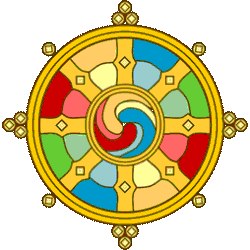
Birth is suffering, old age is
suffering, sickness
is suffering, death is suffering. Involvement with what is
unpleasant
is suffering. Separation from what is pleasant is
suffering.
Also, not getting what one wants and strives for is suffering. ... [In sum,
the] five agglomerations (skandhas), which are the basis of
clinging
to existence, are suffering. (The
Experience of Buddhism, 33)
| The Buddha’s First Noble Truth is the existence of dukkha: pain,
suffering and dissatisfaction. At some time or another, we all
experience grief, unfulfilled desires, sickness, old age, phsyical
pain, mental anguish, and eventually death. We may be happy for a
while, but even when we feel happiness, it may be tinged with fear for we know that this happiness does not last. (Living Religions, 142-3) |

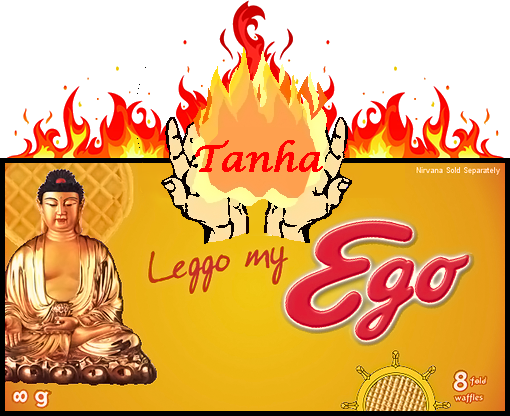
And what is the [second] Noble Truth
of the origination
of suffering? It is the thirst for further existence, which comes
along with pleasure and passion and brings passing enjoyment here and
there. This, monks, is the Noble Truth of the origination of suffering. (The
Experience of Buddhism,
33)
| The Second Noble Truth is that the origin of dukkha
is craving and clinging — to sensory pleasures, to fame and fortune,
for things to stay as they are or for them to be different — and
attachment to things and ideas. The Buddha taught that craving leads to
suffering because of ignorance: We fail to understand the true,
constantly changing nature of the things we crave. We grasp at things
and hold onto life as we want it to be, rather than seeing things as
they are, in a constant state of flux. (Living Religions, 143) |
And what is the [third] Noble Truth
of the cessation
of suffering? It is this: the destruction without remainder
of this very thirst for further existence, which comes along with
pleasure
and passion, bringing passing enjoyment here and there. It is
without
passion. It is cessation, forsaking, abandoning,
renunciation.
This, monks, is the Noble Truth of the Cessation of Suffering. (The
Experience of Buddhism, 33)
| The Third Noble Truth is that dukkha
will cease when craving and clinging cease. In this way, illusion ends,
insight into the true nature of things dawns, and nirvana is achieved.
One lives happily and fully in the present moment, free from
self-centeredness and full of compassion. One can serve others purely,
without thought of oneself. (Living Religions, 143) |
One
thing that is interesting about the Buddha’s statement of the Third
Noble Truth is the few words he uses in comparison to the number used
in stating the other three truths. Perhaps the reason is that the
Buddha never spoke very much about what Nirvana ultimately is. Up to
this point we have been looking at teachings of the Buddha that he
explicates at some length. Therefore, there is not a great deal of
disagreement among scholars about what those teachings entail. However,
this is not the case with Nirvana. In fact, volumes have been written
in which scholars have tried to answer the question, “What is Nirvana?”
Some claim that it is an absolute Truth. Others say it is a
transcendent metaphysical Reality. Still others argue that it is a
supermundane experience or a supreme and pure state of mind. (Buddhism: Introducing the Buddhist Experience,
50)
If there is "no soul" (anatman), then who attains nirvana (whatever "nirvana" means)?
When you open the mind to the truth, then
you
realize there
is nothing to fear. What arises passes away, what is born dies,
and
is not self — so that our sense of being caught in an identity with this
human body fades out. We don’t see ourselves as some isolated,
alienated
entity lost in a mysterious and frightening universe. We don’t
feel
overwhelmed by it, trying to find a little piece of it that we can
grasp
and feel safe with, because we feel at peace with it. Then we
have
merged with the Truth. (Living Religions, 143)
How
might adopting the perspective of "interconnectedness"
(as opposed to "independence") change the way one experiences the world?
|

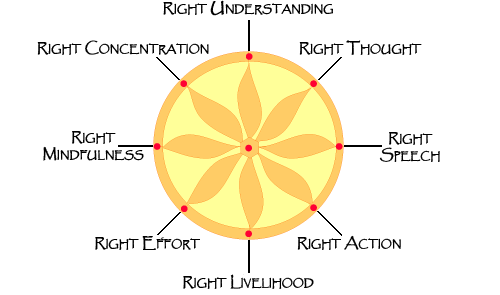
The path can be divided into 3 groups:
Wisdom
|
1. Right Understanding
Adherence to Buddha’s understanding of the Four Noble Truths as a
starting point.
2. Right Thought
Forming the
intention to pursue the Buddha’s path, including the
resolution to practice benevolence or “nonharmfulness” to sentient beings.
|

Morality
|
3. Right Speech
One’s
speech should always be in
accordance with the principle of “nonharmfulness.”
4. Right Action
One’s actions should always be in
accordance with the principle of “nonharmfulness.”
 5. Right Livelihood
In line with the
previous ethical principles, laypeople should pursue a line of work
that
5. Right Livelihood
In line with the
previous ethical principles, laypeople should pursue a line of work
that
promotes the welfare of other sentient beings and minimizes
actions that might harm them.
|

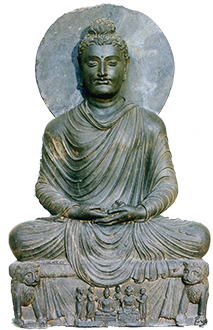 Meditation
Meditation
|
6. Right Effort
The effort to
eliminate harmful karma at the mental level.
This represents the
beginning of
the self-examination process.
7. Right Mindfulness
Mindfulness
meditation employs aspects of the two main techniques of Buddhist meditation:
samatha (calming)
and vipassana (insight).
Samatha
is
good
for stabilizing the mind and preventing new karma,
but only “insight” leads to nirvana.
Mindfulness meditation
combines these by first stabilizing the mind by focusing on the breath
and then directing the mind to contemplate the nature of body, mind,
and their relationship to the totality of things.
 8. Right Concentration
“Concentration” (samadhi)
builds on the practice of mindfulness by focusing on a particular
mental object until one
8. Right Concentration
“Concentration” (samadhi)
builds on the practice of mindfulness by focusing on a particular
mental object until one
reaches a state of “one-pointedness,” which in
turn leads to penetrating “insight” (vipassana) into the object of focus.
There is a traditional list of forty objects for meditative concentration,
ultimately leading to “formless meditations” (arupajhana) on mental objects such as
“nothingness” (sunyata) and “neither perception nor non-perception” (nevasanyanasanyayatana),
which are regarded as the highest states of consciousness that provide a glimpse into the nature of parinirvana —
the final release from samsara that occurs at the death of one who has fully awakened.
|
|

|
